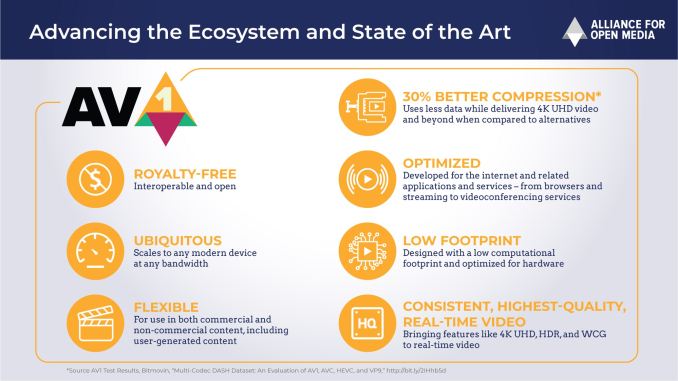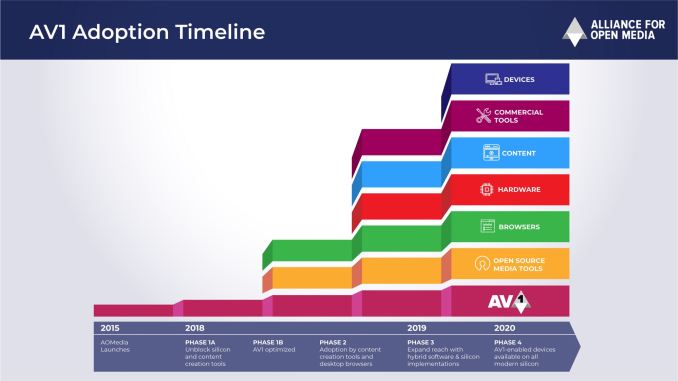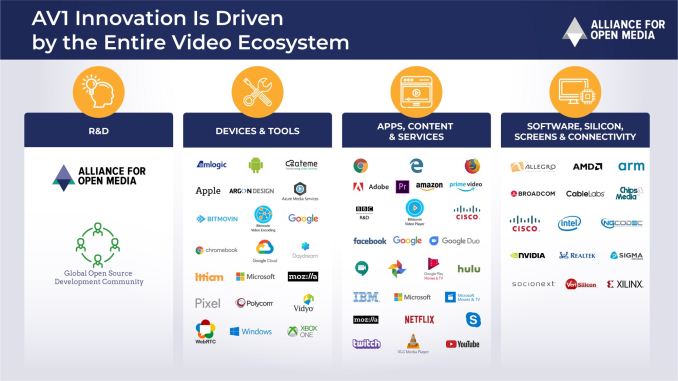Alliance for Open Media Releases Royalty-Free AV1 1.0 Codec Spec
by Anton Shilov on March 30, 2018 11:00 AM EST
Eagerly awaited across the tech industry, this week the Alliance for Open Media (AOMedia) has published the first complete version of the bitstream and decoding process specification for their royalty-free AV1 video codec. The release of the AV1 1.0 spec will enable backers of AOMedia to add support for the technology to their products or services, including taking the all-important step of finalizing the designs for the low-power hardware decoders critical for driving the codec's adoption. At least initially, AV1 will be used primarily for streaming video and user-generated content as an alternative to HEVC and its ongoing royalty disputes, but eventually adoption of AV1 may expand to other applications.
The AV1 open-source video codec was developed with 4K+ ultra-high-def resolutions, HDR, and wide color gamut in mind. Among the key features the new codec, AOMedia mentions a 30% more efficient compression algorithm compared to existing methods, predictable requirements for computational capabilities of hardware, and maximum flexibility and scalability. The backers of the AV1 want the codec to be ubiquitous across devices and platforms, therefore expect it to be supported not only by major chipmakers, software designers, and service providers, but also by leading makers of consumer electronics.
AOMedia does not disclose key technological peculiarities of the AV1 video codec in a short whitepaper form, meanwhile parsing through a 600-page bitstream and decoding spec for developers does not necessarily help to explain all the peculiarities of the tech in general. Therefore, I am going to limit technical details about the AV1 to a necessary minimum here.
On a high level, the AV1 is conceptually similar to existing codecs, such as H.264 or H.265. AV1 uses the same basic elements as various codecs have used for well over a decade: block-based coding, variable block sizes (up to 128x128 pixels), block motion compensation, intra-frame compression, forward-integer transform and so on. Meanwhile, since we are talking about compression algorithms more efficient than existing ones, it is natural that the AV1 has a number of advantages over contemporary codecs.
The AV1 performs internal processing in 8, 10 or 12 bits per sample precision, it also supports all three widespread types of chroma subsampling (4:2:0, 4:2:2, 4:4:4), and virtually all major color gamuts and formats (sRGB, BT.2020 (both 10-bit and 12-bit), BT.2100, etc.). The BT.2020 and the BT.2100 recommendations include support not only for 3840×2160, but also for 7680×4320 (8K) resolution, so the AV1 is technically ready for the next-gen monitors and TVs.
| AV1 Profiles | |||||
| seq_profile | Bit Depth | sRGB Gamut Support | Chroma Subsampling | ||
| 0 | 8 or 10 | No | YUV 4:2:0 | ||
| 1 | 8 or 10 | Yes | YUV 4:4:4 | ||
| 2 | 8 or 10 | No | YUV 4:2:2 | ||
| 2 | 12 | Yes | YUV 4:2:0 YUV 4:2:2 YUV 4:4:4 |
||
Speaking of displays, it is necessary to note that the AV1 was designed to be compatible with existing interconnections, such as DisplayPort, eDP, HDMI and so on. That said, the technology should also be compatible with contemporary content protection technologies.
The publication of the AV1 spec 1.0 is merely the first step towards adoption of the technology by the market. AOMedia expects content creation tools and desktop browsers to begin to roll out support for AV1 later this year. To ensure this, AOMedia released an unoptimized/experimental AV1 software decoder and encoder for use in software applications. Then, sometimes in 2019, the consortium anticipates select chips and programs to support the tech. More widespread support of the AV1 along with adoption by software is projected for 2020.
Speaking of adoption, the list of AOMedia members includes a variety of influential companies, including Apple, Amazon, AMD, Arm, Broadcom, Facebook, Google, Hulu, Intel, IBM, Microsoft, Netflix, NVIDIA, Realtek, Sigma and many others. These companies either control huge ecosystems themselves, or develop chips that are used by hundreds of millions of customers worldwide. Their support will ensure widespread adoption of the AV1 in the next decade. In the meantime, AOMedia has already started R&D for the AV2, which is to succeed the AV1 codec.
Related Reading:
Source: AOMedia



















71 Comments
View All Comments
ZeDestructor - Friday, March 30, 2018 - link
Some interestingly notable hardware companies missing there - Samsung, Qualcomm/Snapdragon, MediaTek, and HiSilicon/Huawei. That's a LOT of missing mobile vendors. Hopefully, between Google, Youtube, Twitch and Netflix, AV1 can be rammed down hard enough everyone else just falls in line with big daddy ARM.Trixanity - Friday, March 30, 2018 - link
I'm not completely sure but I think Samsung and Qualcomm have ties to HEVC. So I think they'd prefer the money made from that instead of backing AV1. That doesn't mean they'll not support it on their chips eventually but I assume they'll try to cling to the standard that makes them money and that they've invested in.Samus - Sunday, April 1, 2018 - link
Know Samsung\Qualcomm, they will probably NERF the implementation of AV1 in their devices to make HEVC appear superior. Lots of way they can do this, from artificially jacking streaming efficiency to only implementing seq_profile_0. Who knows, wouldn't be the first time big corp played money with codec competition.SirPerro - Thursday, April 5, 2018 - link
That'll only damage them in the long termleo_sk - Sunday, April 8, 2018 - link
Qualcomm owns some patents but hasnt yet declared its royalty rates (as part of velos media group)iter - Friday, March 30, 2018 - link
It is a non-issue, the codec will be available on every contemporary platform the moment someone rolls out a hardware accelerated implementation. It is not something that has to be laid down in the silicon.CSMR - Friday, March 30, 2018 - link
The codec won't get going until there is full hardware support including full fixed function decode in most systems out there. CPU-based decoding is just too inefficient for modern video codecs, and GPU-assisted decoding leaves the CPU with too much work, if HEVC is anything to go by. HEVC takes a significant amount of a modern desktop CPU to software-decode - let alone smartphones and TV hardware. AVC1 is more complex by most accounts.iter - Friday, March 30, 2018 - link
There is no fixed function decode on most platforms. It is just hardware accelerated. Video codecs lend themselves very well to general purpose compute, and it would be a complete waste of transistors to make dedicated decoder hardware. Don't let the practice of burying that stuff in the firmware confuse you.brucethemoose - Friday, March 30, 2018 - link
Wait, what? AFAIK most modern hardware has a dedicated decoding block. Some things (like 4K Netflix/Amazon) won't even play without hardware HEVC decoding, even if you have more than enough CPU grunt.StevoLincolnite - Saturday, March 31, 2018 - link
Yeah, nah. Most GPU's feature fixed-function decode ASICs built into the hardware level.AMD Unified Video Decoder exists for a reason and gets updated constantly with new hardware decode options.
https://en.wikipedia.org/wiki/Unified_Video_Decode...
Now you can feel a little more educated on the topic.